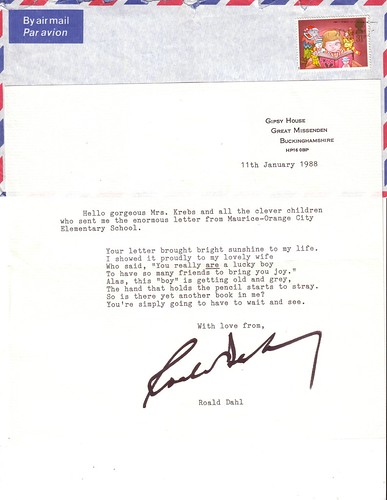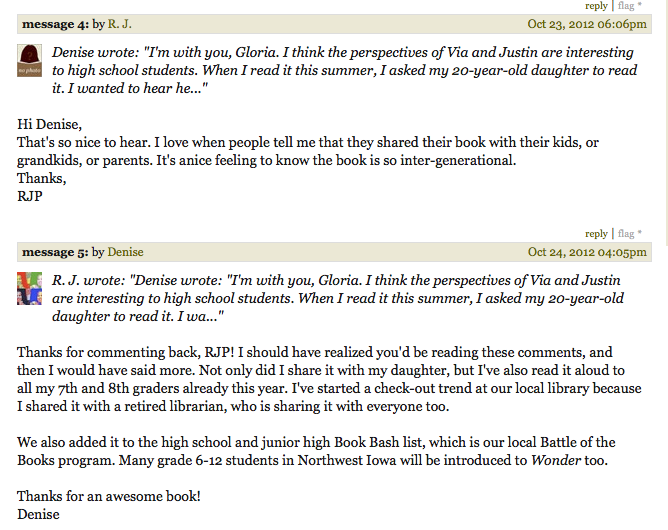When I first started teaching, I typed my students’ stories on an Apple IIE computer and printed them on a dot-matrix printer. I used the book-binding machine in the office to make books for our classroom library. We wrote letters to authors and delighted in their return replies. We had young authors’ days, where parents came in and read to us, and we to them (from our very own writings.) I talked to my students about my favorite authors and poets, and some of my students made my short lists. My goal was always to tell my students, in as many ways as possible, that they were writers.
These were a few ways I tried to blur the lines between authors and student writers, professionally-published books and pieces my students and I wrote. I wanted my students to not just learn English, but to know they were writers.
Fast forward (and it was fast) twenty-five years, and there are myriad ways to accomplish the goal of having my students know they are writers. I still do some of the things above. Except, now we write more blog posts and less hard-copy books in our classroom library. Instead of sending letters on chart paper to authors, we tweet them and share links to blog posts we write about them.
In the 21st century, however, there are clearly brand new ways to blur the line between teachers and students, authors and readers, producers and consumers, professionals and amateurs. As a result of social learning and the Internet, here are some of the new things we’re trying and the sweet results.
 NaNoWriMo
NaNoWriMo
NaNoWriMo for young writers was a delightful find. (More about it here.) Eighth grade students in November come to English class and know just what to do. They write novels. Right now, they are furiously trying to reach their word-count goals by November 30.
Usually all I hear in the classroom that period of the day is light clicking on the keyboard and a tiny bit of music coming from the earbuds of some students. (Writing fiction is the perfect time to listen to music!)
However, a couple Fridays ago, the students seemed restless and talkative. Usually they are fully engaged in writing — anxious to reach their goal. However, this time they were chatting away, but strangely novel-related. I stopped for a bit to listen to the following charming conversation.
“My character has been kidnapped, and I don’t know how to get her saved,” someone said.
“I have a kidnapped character too.”
“Hey, me too.”
“What’s going on? Do we all have kidnappings in our novels?”
I was ecstatic. There were more conversations going on, as well — pockets of authors talking about their craft, not about the coming weekend. They were talking about plots and characters and other novelly-type delights. — It reminded me of the write-ins I go to with a group of adult NaNoWriMo writers. We are all writers.
21st Century Readers
I teach English, which includes both reading and writing for the junior highers. We are not reading group novels, but each student is making reading choices ala Donalyn Miller (the Book Whisperer) and Nancie Atwell. We are keeping track of our readings, but we’re not keeping long reading logs with summaries and responses like we used to. We no longer take A.R. tests.
Now we share books with friends just like real life. We encourage each other to find books we love, so we can make progress toward the 40-book challenge. Some students keep track on GoodReads, and some prefer to write a list in their English handbook. Some listen to audio books. Some read on Nooks and Kindles. Every opportunity to shape learners into life-long readers does not go unexplored.
Connected Authors
The most interesting way that the line has been blurred is through online connections and interactions with “real” authors. These connections have  certainly made me feel more like an author. When we connect with them online, somehow authors seem more like us.
certainly made me feel more like an author. When we connect with them online, somehow authors seem more like us.
Kenneth C. Davis
From a summertime tweet by Don’t Know Much About series author, Kenneth C. Davis, I set up a Skype session for my history class, and my class and Mr. Davis followed each other on Twitter. It reminded me of the Cisco “Welcome to the Human Network” commercial: ”…where the team [author] you follow, now follows you.”
R.J. Palacio
Author of Wonder, the wonderful and wildly popular book, which is on the fast track to becoming an anti-bullying classic. R.J. took part in a Good Reads book club. Funny, the concept is still so new to me that when I left the following comment, I really didn’t expect her to answer back. (Welcome to the Human Network! Remember, Denise?)
Kate Messner
The #TeachersWrite Summer Writing Camp, hosted by Kate, was an amazing experience. We were a group that included professionally-published authors, wannabe authors, and teachers just wanting to be better ‘writing’ teachers. The lines were blurred and we were all members of the same club.
Joanne Levy
Joanne was a member of the #TeachersWrite Summer Writing Camp. She donated a copy of her book Small Medium at Large for a door prize. I just happened to be the winner. I was so excited to receive the autographed copy with a large set of book marks.
Later when I saw Kate’s and Joanne’s books sitting side-by-side on the shelf in our public library, I couldn’t help but think I was looking at books written by my friends.
Sharon Creech
All authors don’t respond back personally. However, even when they don’t, connected authors like Sharon Creech share a new side of themselves and add to their body of work on blogs and through tweeting. Authors’ work is no longer limited to the hard- and paperback books found in the library and book stores.
Those are just four authors that I’ve met on Twitter. Thank you to Joy Kirr for this whole list of other authors on Twitter you can connect with.
What a joy to be a teacher, learner and writer in the 21st century!

